We all constantly see things flying in the sky. Most of the time, they are planes, but sometimes, they are not. Sometimes, you may see objects flying way faster and smaller than the usual planes flying over our heads or the stars that are always there. Well, they are coming from space, falling into Earth. Generally, they are either asteroids or comets. People may think they are very similar – and indeed, they have similarities. But the comet vs asteroid discussion is much more than that.
Check this article out, too: What are Binary Star Systems?
What are comets and what are asteroids, and how do comet vs asteroid differ from each other? Both are leftovers from the early solar system. But they have unique features that make them different. Comets are like “dirty snowballs,” while asteroids are rocky. Also, one of these caused the destruction of dinosaurs. Can you guess which one? Maybe you already know which one!
Can that comet or asteroid hit the Earth again and cause another massive extinction? The answer to this question is also within the comet vs asteroid discussion. The more you learn, the more you will understand what flies above your head and what consequences they may bring. But to give you a short answer – yes it is possible.
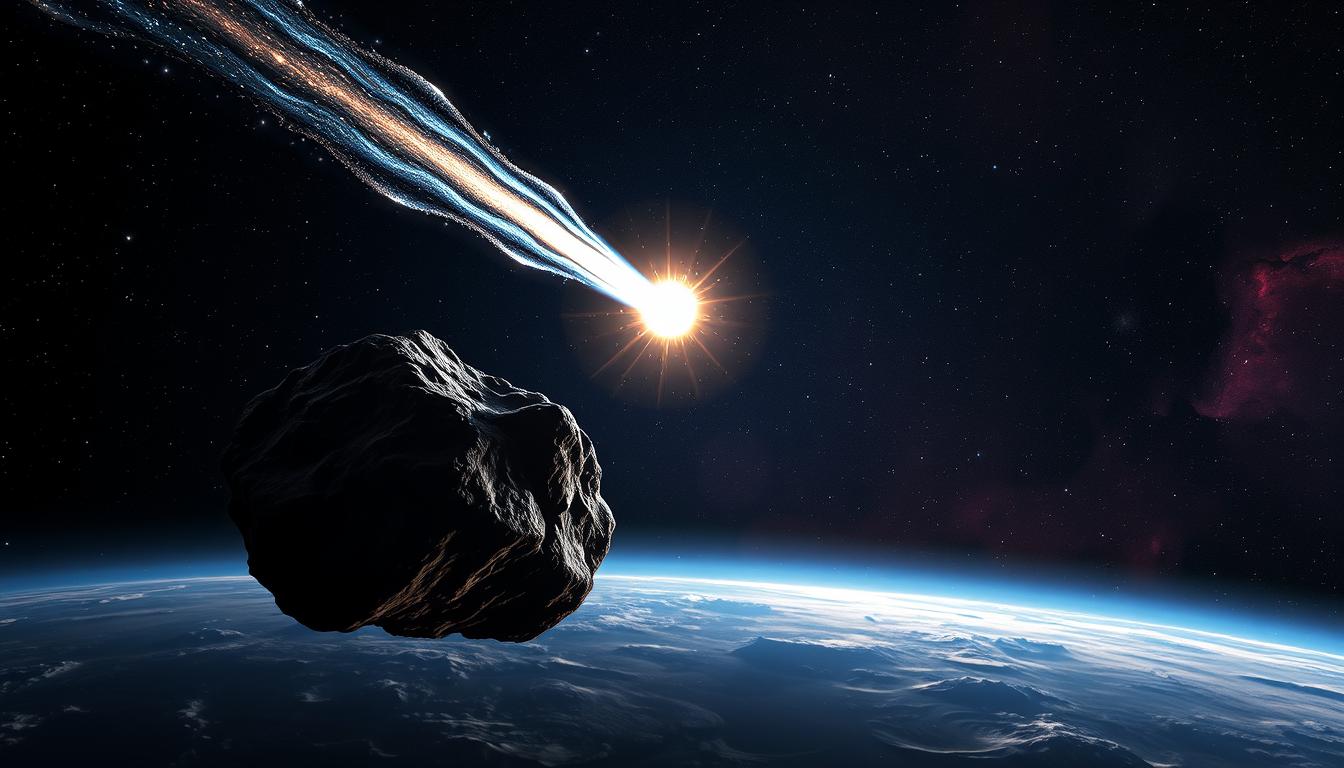
Understanding Comets and Asteroids in Our Solar System
Comets and asteroids are like ancient time capsules because they’ve existed since the first days of our Solar System. They are old pieces from the early days of our solar system. But there are subtle differences about their history, what they are made of, where they are coming from, and similar things.
Origins in the Early Solar System
Comets and asteroids were born when our solar system started, about 4.6 billion years ago. Comets are like icy wanderers from the outer edges of the solar system, forming in cold regions beyond Neptune. They’re made of ice, dust, and rock, which is why they develop bright, glowing tails when they get close to the Sun and heat up.
Asteroids, by contrast, are rocky bodies that mostly form closer to the Sun; they are leftovers from the inner solar system. Think of them as space rubble from when planets were forming. They orbit mostly between Mars and Jupiter, in the asteroid belt, like crumbs left behind after baking cookies.
Their Role in Planetary Formation
Comets and asteroids were key in making our planets. In the early days, tiny bits of rock and ice smashed together to form larger bodies. Asteroids are the foundation of rocky planets like Earth. Comets, full of water and organic stuff, might have brought these vital elements to early Earth. This could have helped life start on our planet.
Comets and asteroids have different homes in space. Asteroids mostly live in the asteroid belt between Mars and Jupiter. Comets come from the distant Kuiper Belt or Oort Cloud. This difference in where they are affects their makeup and how they act.
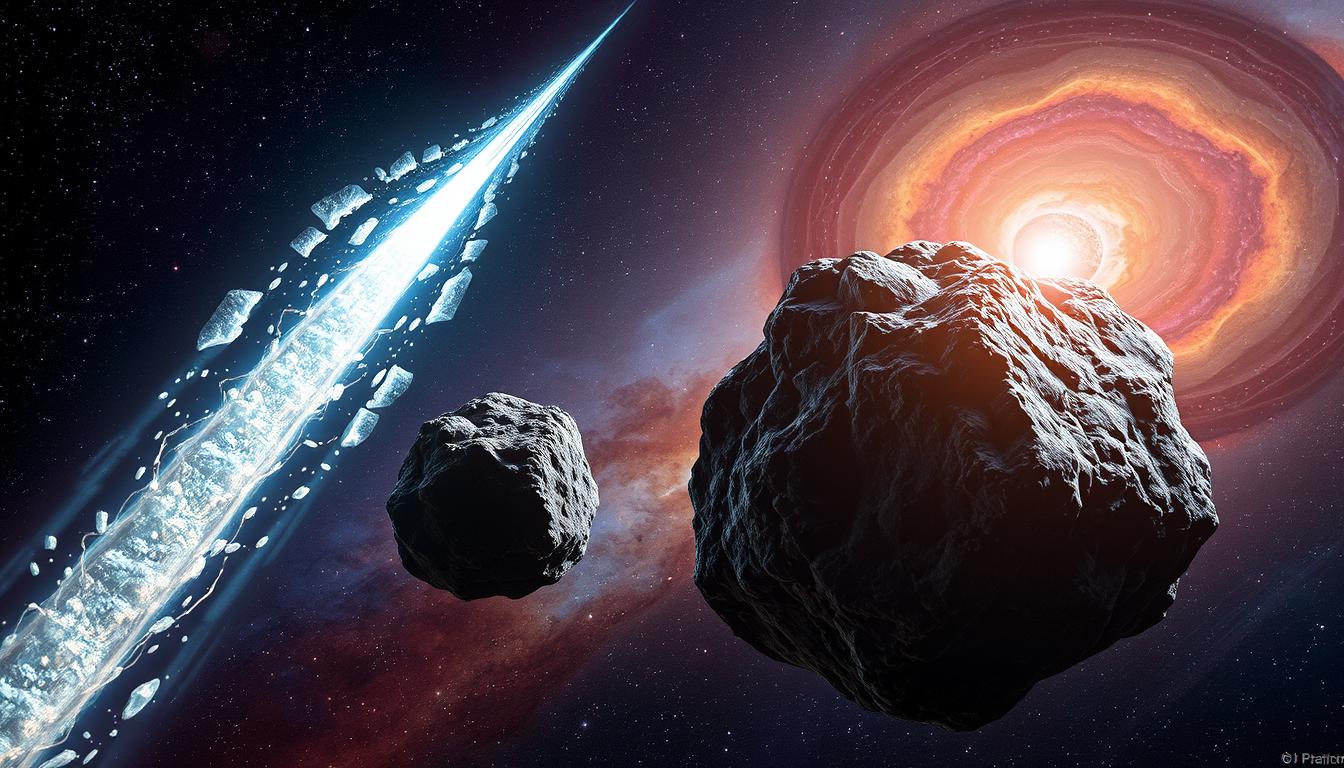
Comet vs Asteroid: Key Differences
They are similar in many senses, but they are different in essence. That’s why it’s hard to separate comet vs asteroid when you are looking at them or when you see them in the sky. When you compare comet vs asteroid – you need to distinguish those small key differences to actually show your point across. There are five key differences.
- Composition: Comets are called “dirty snowballs” because they’re made of ice, dust, and rocks. When they get near the Sun, the ice melts, creating a glowing coma and tail. Asteroids, on the other hand, are rocky bodies without ice, and they are mostly metal.
- Size: Asteroids are bigger, ranging from a few feet to hundreds of miles wide. Comets are smaller, with nuclei rarely over a few miles in diameter.
- Appearance: Comets form glowing tails when near the Sun, thanks to their ice turning into gas. Asteroids, being rocky, don’t do that—they’re like plain rocks in space. Asteroids seem like dim stars through telescopes.
- Orbits: Asteroids mostly orbit the Sun in the asteroid belt between Mars and Jupiter. Comets have more oval orbits, often going far beyond Pluto.
- Location: Asteroids stick closer to the inner solar system, especially in the asteroid belt. Comets come from the outer regions, like the Kuiper Belt or Oort Cloud.
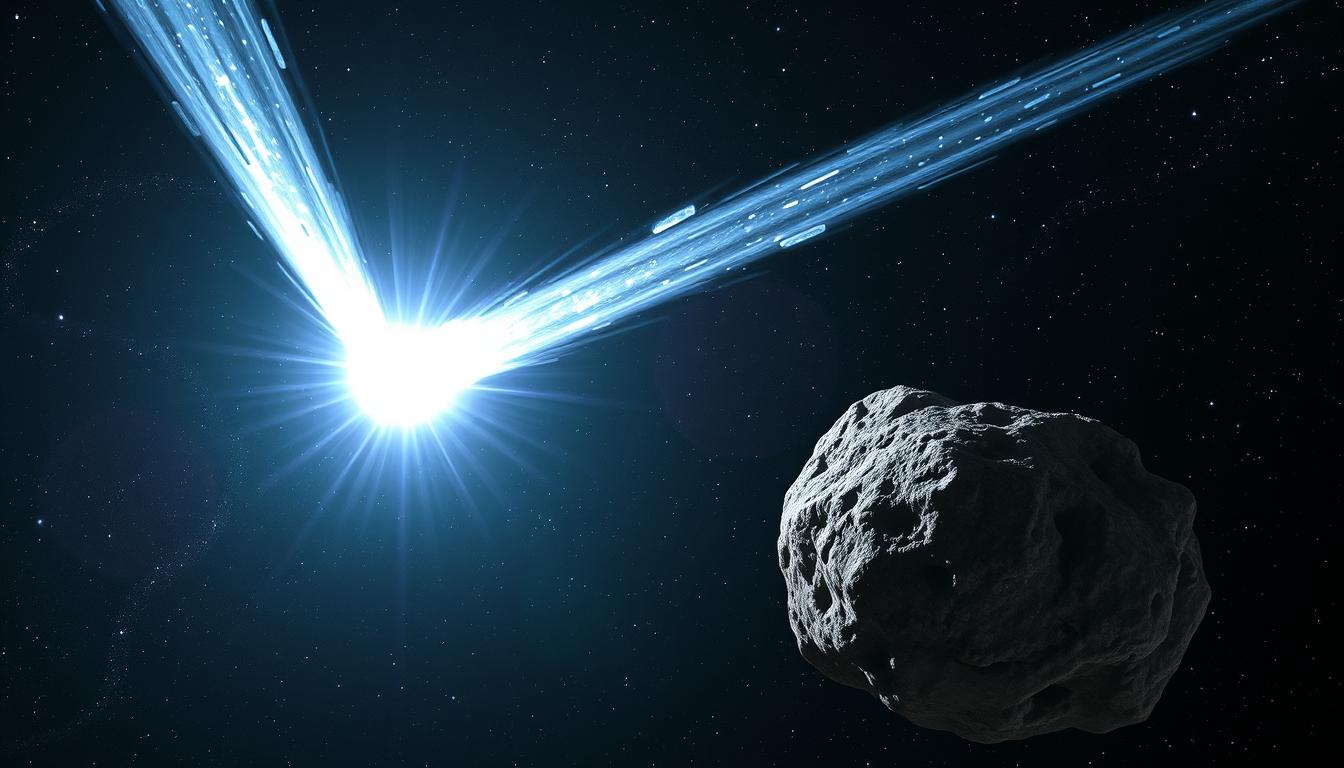
Physical Composition of Comets
Comets are like cosmic snowballs with a dirty, ancient core. Their structure and makeup provide invaluable insights into the conditions of the early solar system. Let’s break down what makes these icy travelers so unique.
Nucleus Structure
The nucleus is at the heart of every comet—the solid, frozen core. The nucleus of a comet is like a “dirty snowball.” It’s made of ice, dust, and rocky particles. Frozen water, carbon dioxide, methane, and ammonia are among the ice types. Despite its small size, typically only a few kilometers wide, the nucleus has a lot of information about the comet’s formation. Picture a mix of frozen water, gases, dust, and rocky particles all compacted together. This core remains inactive while the comet drifts in the cold, distant regions of the solar system. When comets get close to the Sun, these ices turn directly into gas. This creates the comet’s coma and tail. The nucleus is the engine driving a comet’s stunning transformation.
Key Components
Comets are more than just ice. The coma, a fuzzy atmosphere, forms as they near the Sun. It’s made of gas and dust from the nucleus. Comets are made up of three primary ingredients.
- Ice: Comets are rich in frozen water, but they also contain other ices, like carbon dioxide, methane, and ammonia. These ices are a snapshot of the frozen gases that existed when the solar system formed billions of years ago.
- Dust and Rocks: Embedded within the ice are dust particles and rock chunks. These materials are like fossils, preserving the raw building blocks of planets. This is why comets are often referred to as “dirty snowballs.”
- Organic Compounds: Some comets contain complex carbon-based molecules, such as amino acids, which are essential for life. Scientists study these compounds to explore the possibility that comets may have delivered the raw ingredients for life to Earth.
As the ice and dust are released during the comet’s journey near the Sun, the material streams out into space, forming a coma and a tail. This makes comets beautiful to observe and vital tools for understanding the birth and evolution of our solar system.
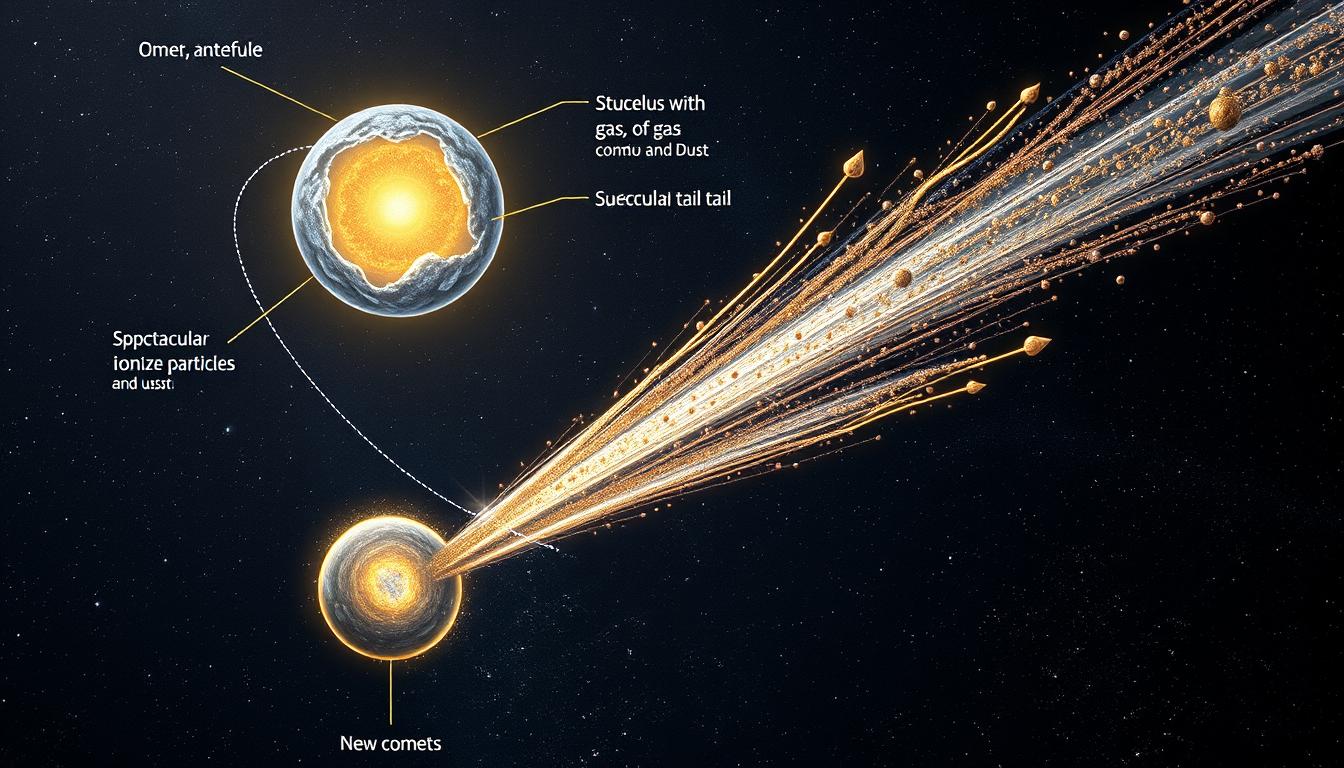
Asteroid Composition and Structure
Asteroids are rocky bodies that orbit the Sun. They come in different types, each telling us something about the early solar system. Let’s dive into what makes them unique. There are three main types of asteroids. Carbonaceous asteroids (also known as C-type asteroids) are rich in carbon and organic compounds. Silicaceous asteroids (S-type) are rocky, with minerals like olivine. Metallic asteroids (M-type)are mostly iron and nickel.
Asteroids are different from comets in structure. Comets have icy cores, but asteroids are solid all the way through. Some asteroids are just piles of rubble held together by gravity. Others are single, solid rocks. Asteroid structures can be quite different. Some have moons or ring systems. Others show signs of past collisions.
Orbital Patterns and Behavior
Comets and asteroids don’t just float randomly in space; their movements follow specific paths that reveal a lot about their origins and how they interact with the solar system. So that’s why these patterns and behaviors can also help us distinguish them when comparing comet vs asteroid.
Comet Trajectories and Periods
Comets follow highly elliptical orbits, like stretched-out ovals. This means they spend most of their time far from the Sun before swinging close to the Sun in dramatic, high-speed passes. Some comets take hundreds or thousands of years to orbit the Sun once. There are two types of comets based on their orbital periods:
- Short-period comets: These take less than 200 years to complete an orbit. They often originate in the Kuiper Belt, a region beyond Neptune. Halley’s Comet, for example, returns every 76 years.
- Long-period comets: These take thousands or even millions of years to orbit the Sun. They’re thought to come from the Oort Cloud, a distant shell of icy objects surrounding the solar system.
These long, sweeping paths explain why some comets appear in the sky only once in a lifetime while others make more regular appearances.
Asteroid Belt Dynamics
Asteroids, compared to comets, typically have more circular orbits. Most of them are concentrated in the asteroid belt, a region between Mars and Jupiter. This belt is like a crowded highway of rocky bodies. The asteroid belt formed from leftover material that never coalesced into a planet due to Jupiter’s immense gravity. This gravitational tug prevents asteroids from forming a single large body, keeping them as a scattered, rocky population. Though most asteroids remain within the belt, occasional collisions or gravitational nudges can send some spiraling toward the inner solar system. These rogue asteroids can cross paths with Earth. When they do, we label them as Near-Earth Asteroids.
Near-Earth Object Classifications
Near-Earth Objects (NEOs) are asteroids and comets whose orbits bring them close to Earth. Check how many NEOs are registered here. They are divided into categories based on how their orbits compare to ours:
- Amor asteroids: These approach Earth but never cross its orbit.
- Apollo and Aten asteroids: These cross Earth’s orbit at different points, making them potential collision risks.
- Potentially Hazardous Objects (PHOs): These are NEOs that come within 7.5 million kilometers of Earth and are large enough to cause significant damage if they collide with our planet.
NASA and other space agencies monitor NEOs closely, not only to track potential threats but also to study them as remnants of the early solar system.
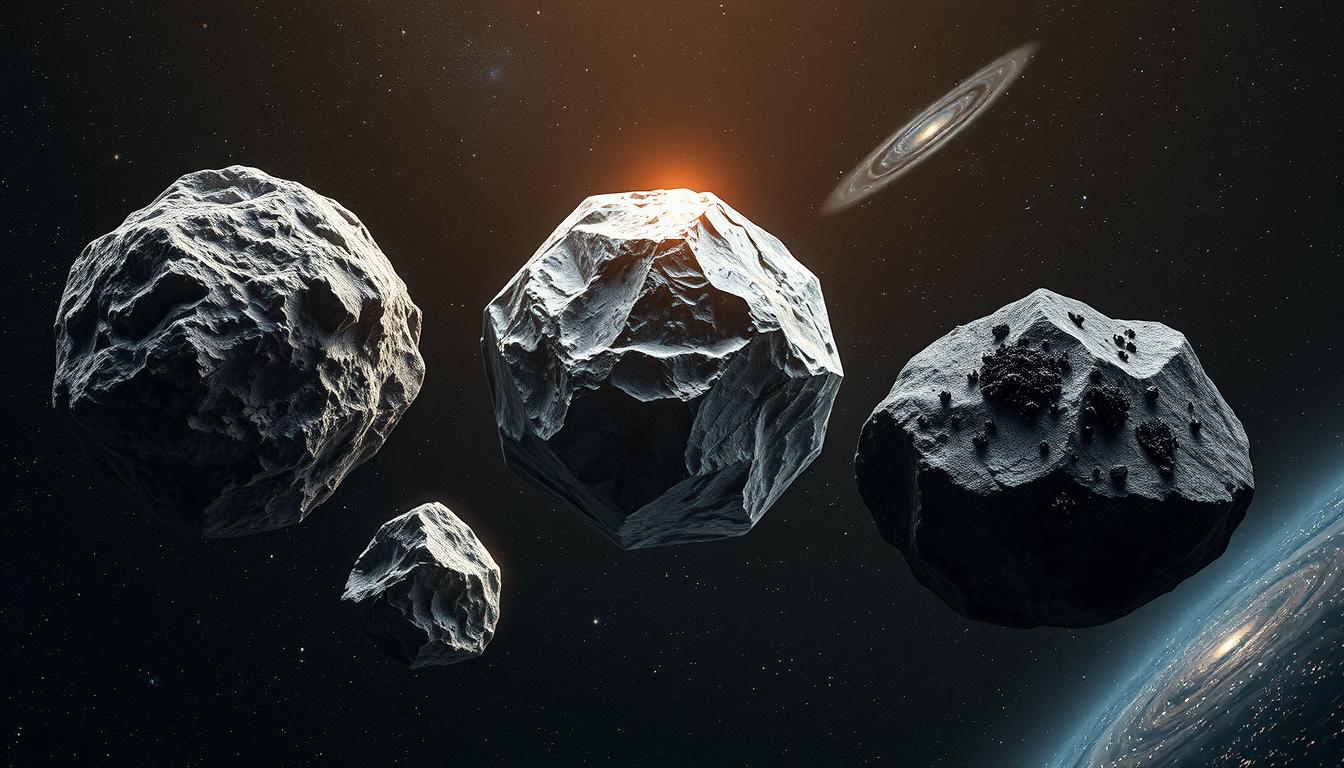
Size Ranges and Mass Comparisons
Size is key when comparing comets and asteroids. Asteroids vary greatly in size, from small pebbles to huge space rocks. The biggest asteroid, Ceres, is 940 kilometers wide. Comets are smaller. They range from a few hundred meters to tens of kilometers. Comets are also generally lighter than asteroids. A comet’s mass is between 10^13 to 10^14 kg. Asteroids, like Vesta, can weigh much more, around 2.59 × 10^20 kg.
Asteroids are rocky and often contain metals, making them denser. Comets, mostly ice and dust, are less dense. This is why comets can appear larger, even though they’re lighter.
Impact Events Throughout History
Earth has seen many visitors from space. These visits have changed our planet and life. These visits from comets and asteroids have left their marks on Earth. Some encounters were awe-inspiring, while others caused destruction. Was it a comet or an asteroid that brought the destruction of dinosaurs? It was an asteroid.
Famous Comet Encounters
One of the most famous is Halley’s Comet, which appears about every 76 years. It was recorded as far back as ancient times and is often linked to significant historical events, like the Norman Conquest in 1066.
Another notable comet is Comet Hale-Bopp, which passed by in 1997. It stayed visible for months, even to the naked eye. It was one of the brightest and most widely observed comets of the 20th century.
Significant Asteroid Impacts
Asteroids, unlike comets, are more likely to collide with Earth. These impacts can range from small meteors burning up in the atmosphere to catastrophic events. The most famous event was 66 million years ago. Yes, the one that brought the destruction of dinosaurs. An asteroid hit the Yucatan Peninsula.
One thing that many people seem to miss with this is that the asteroid didn’t directly kill them. It created such a massive effect on Earth that the atmosphere changed. It brought darkness, acidic rain, clouds, and bad weather for thousands of years. This killed the food source of dinosaurs. They couldn’t adapt to these sudden changes, and they went extinct – with more than 85% of the entire population of Earth.
In more recent history, the Tunguska event in 1908 flattened over 2,000 square kilometers of Siberian forest. Scientists think it was caused by a smaller asteroid or a comet exploding in the atmosphere. Even smaller impacts, like the Chelyabinsk meteor in 2013, remind us that these space rocks still pose a threat. The Chelyabinsk explosion damaged buildings and injured over 1,000 people in Russia.
Both comets and asteroids can cause a lot of damage. Asteroids make bigger craters because they are rocky. Comets explode in the air because they are icy.
Comets and Dark Matter
These space rocks are fascinating to astronomers because of their icy makeup and stunning tails. They might also help solve a big mystery: dark matter. Scientists are looking into how comets could reveal secrets about this invisible substance.
Comets are icy bodies that orbit the Sun. They are made of dust, rock, and frozen gases. Their unique makeup makes them very sensitive to gravity. Some scientists believe dark matter could affect their paths in ways we can observe.
One theory is that comets might interact with dark matter particles as they move through the galaxy. This interaction could change their paths slightly. By studying these small changes, scientists aim to understand where dark matter is in our galaxy.
Another idea is that dark matter could have influenced how comets formed. The early solar system was very chaotic, and dark matter might have played a role in comet formation. Learning about this could give us new insights into comets and dark matter.
Asteroids and Dark Matter
Asteroids, like comets, can also reveal some secrets about dark matter. It’s thought that dark matter could change how asteroids are made. Some scientists believe dark matter particles could build up inside asteroids. This could change how they act and what they’re made of. The link between asteroids and dark matter is mostly theory right now. I think it is more theory-based than the connection between comets and dark matter.
Conclusion
Comets and asteroids are not that different from each other. They vary in specific things like their composition and where they move around. That’s why the comet vs asteroid comparison is important to make, especially if you are new to astronomy.
Comets are icy and watery, and asteroids are rocky – dealing more damage if they ever hit Earth. Comets, with their icy centers and bright tails, pass by the Sun. Asteroids, on the other hand, are rocky and metallic, moving quietly through space, mostly in the asteroid belt.
Comets and asteroids each have their own part in our solar system’s history. Their different materials and paths tell a lot about the Solar System and its past. The difference between asteroids and comets shows us how planets formed and how materials spread in space.
FAQ
What’s the main difference between a comet and an asteroid?
Comets are icy bodies that release gas and dust near the Sun, creating a coma and tail. Asteroids are rocky or metallic and don’t show this activity. Comets are like “dirty snowballs,” while asteroids are space rocks.
How did comets and asteroids form?
They formed early in our solar system, about 4.6 billion years ago. They’re leftovers from planet formation. Comets formed in the cold outer regions, while asteroids formed in the warmer inner regions.
What are comets made of?
Comets have ice, dust, and rocky particles. Their nucleus holds these frozen gases and dust. When near the Sun, these ices turn into gas and dust, creating a coma and tail.
What are asteroids made of?
Asteroids are made of different materials. They’re mainly C-type (carbonaceous), S-type (silicaceous), and M-type (metallic). C-type asteroids have clay and silicate rocks, S-type has silicate and nickel-iron, and M-type is mostly iron.
How big are comets and asteroids?
Comets are small, from hundreds of meters to tens of kilometers wide. Asteroids can be tiny or huge, with the largest being Ceres, which is about 940 km wide.
Can comets and asteroids hit Earth?
Yes, they can hit Earth. Our planet has been hit by these objects before. The impact that killed the dinosaurs was likely caused by an asteroid. But big impacts are rare, and we watch near-Earth objects closely.
What is the asteroid belt?
The asteroid belt is between Mars and Jupiter. It’s filled with millions of asteroids, from small rocks to huge objects. The largest object there is the dwarf planet Ceres.